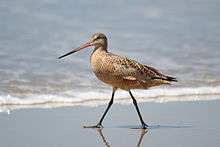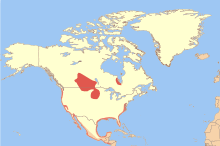Marbled godwit
The marbled godwit (Limosa fedoa) is a large shorebird. On average, it is the largest of the 4 species of godwit. The total length is 40–50 cm (16–20 in), including a large bill of 8–13 cm (3.1–5.1 in), and wingspan is 70–88 cm (28–35 in).[2] Body mass can vary from 240 to 510 g (8.5 to 18.0 oz).[3]
| Marbled godwit | |
|---|---|
 | |
| Scientific classification | |
| Kingdom: | Animalia |
| Phylum: | Chordata |
| Class: | Aves |
| Order: | Charadriiformes |
| Family: | Scolopacidae |
| Genus: | Limosa |
| Species: | L. fedoa |
| Binomial name | |
| Limosa fedoa | |
 | |
| Range of L. fedoa Breeding Range Non-breeding Range | |
| Synonyms | |
| |
Adults have long blue-grey legs and a very long pink bill with a slight upward curve and dark at the tip. The long neck, breast and belly are pale brown with dark bars on the breast and flanks. The back is mottled and dark. They show cinnamon wing linings in flight.
They nest on the ground, usually in short grass.
These birds forage by probing on mudflats, in marshes, or at the beach (see picture below). When the tide is out, they eat. In short grass, they may pick up insects by sight. They mainly eat insects and crustaceans, but also eat parts of aquatic plants.
When the tide is in, they roost. They often sleep by standing on one leg and tucking their bill into their body (see picture below).[4]
Their numbers were reduced by hunting at the end of the 19th century. Although they had recovered somewhat since that time, their population has declined in recent times as suitable habitat is used for farming.
Subspecies
There are two subspecies of the marbled godwit:
- L. f. beringiae, (Gibson & Kessel, 1989), breeds in the northern part of the Alaska Peninsula
- L. f. fedoa, (Linnaeus, 1758), breeds in Canada and the US
Migration
Marbled godwits breed in three distinct areas with their own unique route. The vast majority occur in mid-continental North America, followed by eastern Canada and the Alaska Peninsula, USA. In addition, the largest winter ranges are the Atlantic, Pacific and Gulf coasts of the US and Mexico.[5]
Godwits breeding in the western USA and Canada follow a route through the Utah stopover site, with a final arrival in the winter sites of Mexico. Species breeding in eastern Canada migrate across the US, and stopover at sites along the Gulf of California and Mexico. Furthermore, those breeding in North and South Dakota winter in coastal Georgia.[6]
The Bear River Migratory Bird Refuge located at Great Salt Lake in Utah (USA), is one of the most popular stopover sites for godwits in the spring and fall.
Gallery
 Feeding on mudflat at low tide, Elkhorn Slough
Feeding on mudflat at low tide, Elkhorn Slough Marbled godwits feeding, Point Reyes National Seashore, California
Marbled godwits feeding, Point Reyes National Seashore, California
 In flight
In flight Flock
Flock Sleeping at Balboa Peninsula, Newport Beach, California.
Sleeping at Balboa Peninsula, Newport Beach, California. Bodega Bay, California
Bodega Bay, California
References
- BirdLife International (2012). "Limosa fedoa". IUCN Red List of Threatened Species. 2012. Retrieved 26 November 2013.CS1 maint: ref=harv (link)
- (2011).
- CRC Handbook of Avian Body Masses by John B. Dunning Jr. (Editor). CRC Press (1992), ISBN 978-0-8493-4258-5.
- Lentz, Joan Easton (November 2005). Introduction to Birds of the Southern California Coast. University of California Press. p. 151. ISBN 9780520243217. Retrieved 27 December 2017.
- Olson, Bridget E.; Sullivan, Kimberley A.; Farmer, Adrian H. (May 2014). "Marbled Godwit migration characterized with satellite telemetry". The Condor. 116 (2): 185–194. doi:10.1650/CONDOR-13-024.1. JSTOR 90008440.
- Olson, Bridget E.; Sullivan, Kimberley A.; Farmer, Adrian H. (May 2014). "Marbled Godwit migration characterized with satellite telemetry". The Condor. 116 (2): 185–194. doi:10.1650/CONDOR-13-024.1. JSTOR 90008440.
External links
| Wikimedia Commons has media related to Marbled Godwit. |
| Wikispecies has information related to Limosa fedoa |
- Marbled Godwit Species Accounty - Cornell Lab of Ornithology
- Marbled Godwit - Limosa fedoa - USGS Patuxent Bird Identification InfoCenter
- "Marbled Godwit media". Internet Bird Collection.
- Marbled Godwit photo gallery at VIREO (Drexel University)
